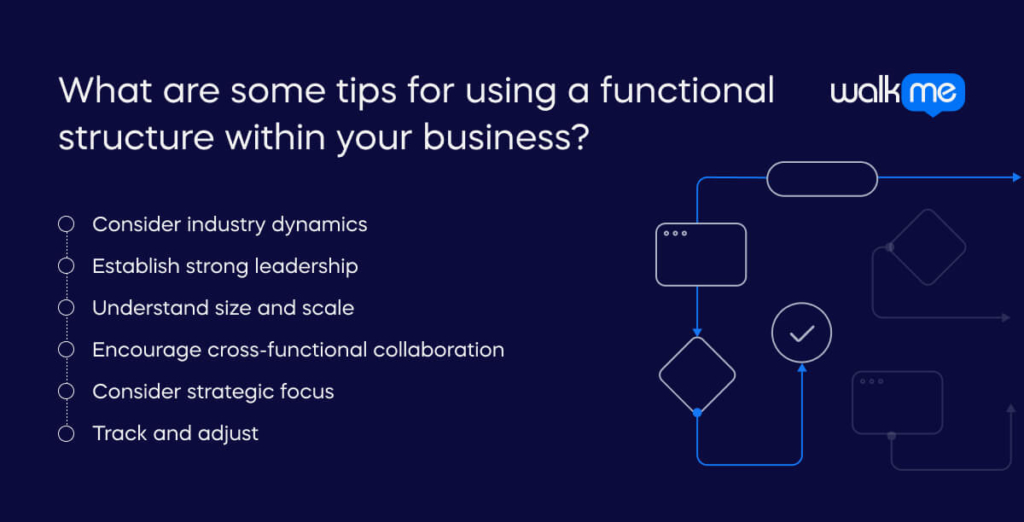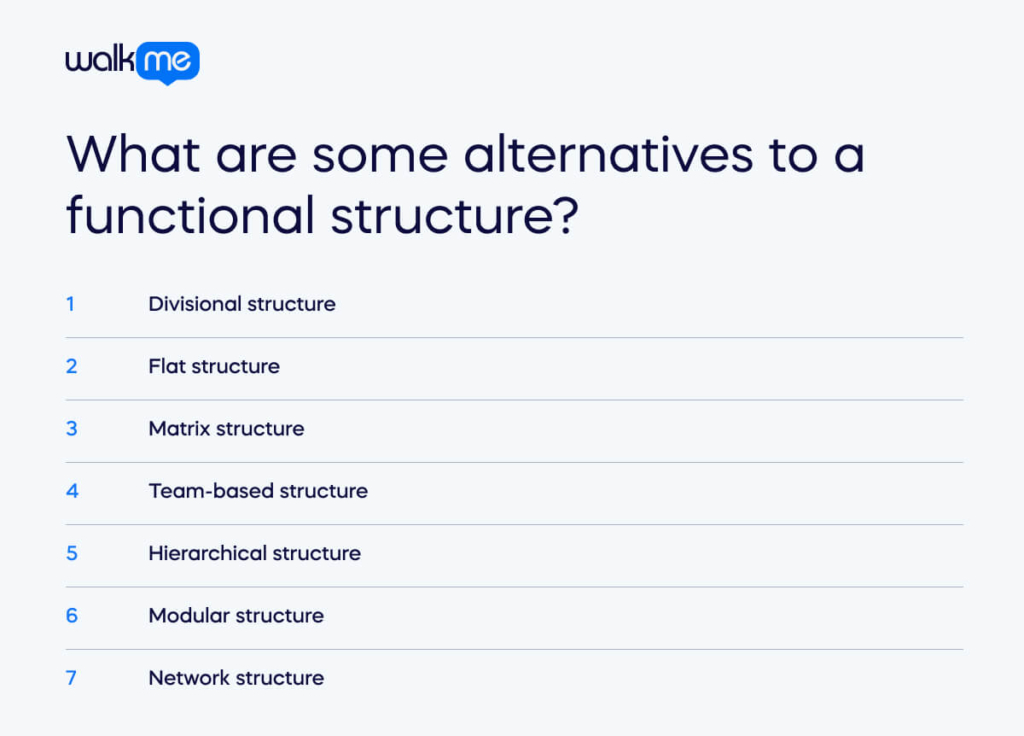An organizational structure helps a business achieve its goals.
Establishing distinct roles, routines, and hierarchies improves your team’s potential and efficiency.
Without a structure, employees may have difficulty determining their official reporting lines. Businesses without a solid framework can also face challenges in sustaining employee productivity.
The functional organizational structure groups employees into specialized departments based on their expertise.
This article will explain functional structures and examine their key characteristics. Next, we will explore a case study and its advantages and difficulties. To wrap up, we will discuss implementation tips and consider alternative organizational structures.
What is a functional structure?
A functional organizational structure categorizes a company into specialized departments based on skill. It works by having designated leaders oversee various departments within hierarchical levels. Businesses often adopt this structure to group individuals with similar knowledge. This helps them achieve goals in a team setting.
What are the key characteristics of a functional structure?
The key features of a functional organizational structure are:
- Top-down hierarchical structure: Functionally structured companies feature a senior management team overseeing the organization. Most employees belong to specific departments.
- Heads reporting to management: Those who lead departments report to senior management.
- Specialization of employees: You can hire employees for particular skills. This is so they remain focused on their designated roles. They also do not stray into tasks outside their department’s domain.
When should you use a functional structure within an organization?
The functional organizational structure is most beneficial for large enterprises. It improves operations by aligning departments based on skills. Business owners can focus on broader goals. Department leaders oversee their teams’ efforts.
Despite similarities to a divisional structure, there are obvious differences. You can group employees in a functional structure based on specialization. This could include accountants working in the accounting department. You can arrange employees across product or service lines in a divisional structure. This results in separate marketing departments for each product.
Businesses with a single product or service can enjoy a functional structure.
Bigger companies with various products or services often find divisional structures helpful. This is because they enable customization for each region, division, or sector. This may differ depending on the business’s products, objectives, and requirements.
The costs of operating each organizational structure vary. Divisional structures often lead to increased costs. This is because they need duplicate positions and resources across each division. However, functional structures are cheaper. This is due to less frequent role duplication and greater sharing across the company.
What is an example of a functional structure?

Let’s use a fictional example to outline what a functional structure is:
Company LMN, operating with a functional organizational structure, has 600 employees. This business specializes in manufacturing car parts. The company has created various departments. These include finance, operations, merchandising, IT, engineering, product development, marketing, and retail.
Each department’s employees have an obligation to their team managers. They then report to the department manager. In the end, the CEO receives reports from all department managers. For example, the marketing department comprises employees who promote new products. The marketing manager oversees these individuals. They report to the marketing head manager, who communicates with the CEO.
What are some tips for using a functional structure within your business?

Here are some tips on implementing a functional structure within your organization:
Consider industry dynamics
Before adopting this structure, you must understand the dynamics of your industry. Analyze how your sector grows and responds to changes. Growing industries may find traditional functional structures constraining. Staying competitive in fast-paced environments requires a high level of agility. Determine if a functional structure matches the fast-paced nature of your industry. Also, check if it empowers your organization to respond to market demands.
Establish strong leadership
Strong leadership is crucial for the success of a functional organizational structure. Each department needs leaders with the skills to handle interdepartmental dynamics. These leaders are critical for creating a unified work environment.
They can help with effective communication and aligning department goals with organizational objectives. Empowering capable leaders fosters accountability, drives performance, and encourages organizational collaboration.
Understand size and scale
The size and scale of your organization determine how this structure will work. Functional arrangements can provide clarity that larger enterprises often enjoy.
This is because of their complex operations and extensive workforce. Defining roles and reporting lines is crucial for efficient operations and reducing confusion.
With a functional structure, big organizations can handle many functions well. In contrast, smaller businesses might perceive functional structures as rigid. This could impede their agility and innovation.
Encourage cross-functional collaboration
Successful functional organizational structures rely on fostering collaboration and synergy across departments. Organizations need to foster a culture that prioritizes open communication and teamwork. Promoting cross-functional collaboration fosters innovation, dismantles silos, and improves problem-solving.
Collaborative meetings and team-building activities help cross-departmental collaboration. It also assists with knowledge sharing among employees. Shared project management tools and collaborative platforms enable smooth communication and coordination. This leads to increased efficiency and effectiveness throughout the organization.
Consider strategic focus
Ensuring the company’s strategic direction and organizational structure align is crucial. When assessing a functional structure, organizations should consider their strategic priorities. Do you want to broaden your market presence and product range?
Or do you prefer to concentrate on improving your core strengths? The organization’s strategic focus influences the implementation of its organizational structure.
Organizations seeking a diverse business strategy may need an adaptable organizational model to accommodate developing market dynamics and emerging opportunities.
Track and adjust
Managing a functional organizational structure requires continuous evaluation and change. It is crucial to assess performance and effectiveness regularly. Track key performance indicators and gather employee feedback. You can also conduct organizational assessments.
It is also important to keep up with industry trends. Organizations can drive sustainable growth and success by embracing change and being agile.
What are the benefits of a functional structure?

Here are the major benefits of a functional structure:
Clear career paths and specialization
Functional structures provide clarity and direction for professional development. This is because they can offer well-defined career paths within specialized areas. It also increases employee motivation and engagement.
It allows employees to develop specialized skills that enhance efficiency and productivity. The hierarchical structure often promotes productive employees. This is a way for the firm to acknowledge their hard work and commitment.
Management hierarchy and coordination
The management hierarchy in functional structures promotes effective coordination and communication between departments. Departmental specialists act as focal points. They ensure effective delegation and close monitoring of tasks.
Clear reporting lines and well-defined roles enable effective supervision and streamlined decision-making. Organizations can boost performance through accountability and collaboration by adopting this structured approach.
Flexibility and adaptability
Functional structures enable businesses to adjust to changing needs without extensive restructuring. This makes them well-suited for dynamic environments. The ability to adapt enhances competitiveness. This structure allows responses to changes in customer demands, market conditions, and technology.
Operational efficiency and specialization
The structure of functional departments aims to optimize operational efficiency. It does this by grouping individuals with complementary skills and expertise.
Management is the hub connecting different functional areas, enabling coordination and collaboration. Functional structures cut costs and boost productivity. It can also drive sustainable growth by minimizing duplication and optimizing resource allocation.
Stable work environment
Within a functional structure, employees enjoy a stable work environment. You can shape this environment through clear expectations and defined roles. This gives employees a comprehensive understanding of their job responsibilities, contributing to a sense of security and confidence in their roles.
This clarity promotes job satisfaction and reduces uncertainty. It fosters a positive work culture and improves the employee experience. Functional structures empower employees to contribute to organizational success.
What are the challenges of a functional structure?

But, there are also some limitations to using a functional structure. These are:
Specialization
Specializing within functional departments has advantages, but it can also become challenging. Sudden changes in the business environment can occur, and specialized teams might have trouble adapting when market conditions change. This lack of flexibility can hinder competitiveness in fast-paced industries that need adaptability.
Silos and competition
Functional structures often encounter the common risk of silos within departments. Silos can foster specialization and efficiency within each unit. But, they result in limited communication and collaboration across departments.
Departments may foster competition, prioritizing their own objectives over collective success. The silo mentality hampers comprehension of company-wide objectives. It also weakens collaboration between different departments.
Missed opportunities for innovation
Specialized departments’ insular nature can impede innovation and creativity in the organization. This is because they limit employees to their own departments. This can cause them to overlook valuable insights that could ignite innovative ideas.
The combination of diverse skill sets in cross-functional collaboration leads to innovation. However, functional structures with independent departments lack this. There’s a danger of missing out on solutions that arise from collaboration.
Impact on morale and career development
Functional structures have the potential to affect employee morale and career development. When work becomes too specialized and lacks variety, employees may feel bored. This can also result in frustration and decreased morale.
The lack of career exploration outside one’s expertise can worsen these problems. It also limits the organization’s ability to maximize its workforce potential.
Resource imbalance
Functional structures can also present challenges in resource allocation. Inefficient allocation of resources may lead to wastage in certain departments.
Others may need more resources, hindering their ability to meet objectives. The imbalance can affect the organization’s performance. Optimal resource use is crucial for efficiency and value creation.
What are some alternatives to a functional structure?

Here are some alternatives to a functional structure:
Divisional structure
A divisional structure organizes teams in a company by products, services, or markets. Every division functions with its own resources, objectives, and leaders.
This framework allows businesses to customize their strategies for specific products or markets. It makes it easier to adapt to market changes. The divisional structure enables teams to innovate and adapt. It does this through decentralizing decision-making and resources.
Flat structure
A flat structure simplifies organizational hierarchy by eliminating middle management layers. It also encourages collaboration and empowerment by minimizing the separation between staff-level employees and upper management.
Employees get more autonomy and decision-making power at lower levels of authority. This encourages employees to take ownership and contribute, promoting agility and innovation within the organization.
Matrix structure
The matrix structure blends functional and project-based structures. In a matrix structure, employees have dual reporting relationships. This is for both a functional manager and a project manager.
This promotes efficient resource allocation and cross-functional collaboration. Employees bring their specialized skills to project teams. They remain connected to their functional departments. The matrix structure is ideal for organizations in dynamic environments. These companies have many projects and diverse stakeholder needs.
Team-based structure
Within a team-based structure, you can organize employees into cross-functional teams. These teams have the authority to make independent decisions and can work towards specific organizational goals.
They promote innovation and improve processes. Team-based structures encourage collaboration and shared accountability. It develops a culture of trust and mutual support, unlike hierarchical structures. Team-based structures promote open communication and breakdown silos. They allow organizations to adapt to market changes and customer needs.
Hierarchical structure
The hierarchical structure follows a pyramid-like chain of command. It delegates decision-making authority from top executives to middle managers and front-line employees.
Hierarchical structures offer clarity in reporting and decision-making. But they can also be inflexible and slow to adapt. The centralization of authority in hierarchical structures can also hinder innovation and creativity. It can make employees feel restricted by bureaucracy and layers of hierarchy.
Modular structure
The modular structure arranges employees into specialized business units. You call these modules, each with its own unique expertise. Organizations can adapt to market changes by reallocating resources in modular structures. They can also adjust priorities.
Network structure
The decentralized organizational model, known as the network structure, promotes collaboration and interconnectivity. Managers in a network structure manage relationships with both internal and external stakeholders. They can focus on open communication and information sharing. This allows organizations to tap into diverse expertise and resources. Network structures help organizations adapt and seize new opportunities in a changing market.
What is the future of a functional structure?
A strong organizational structure is essential for business growth and success. In a functional organizational structure, departments can be created according to specific functions, such as marketing, sales, finance, and HR. This framework is especially well-suited for organizations with stable operations.
It is most effective for larger companies that focus on technical expertise. These include manufacturing, accounting, or law firms. This type of structure enhances task efficiency and skill development among employees. It also enables individuals to hone their expertise.
It’s important to know that this structure has disadvantages, including segregation and limited coordination. The type of structure depends on various factors, including company size and specific needs. Customizing the structure is essential for promoting efficiency and collaboration.

Common Questions
Functional structures can create silos, hindering cross-departmental collaboration essential for digital transformation. Implementing cross-functional teams can mitigate this by promoting interdepartmental communication and agility.
The hierarchical nature of functional structures can slow decision-making, as approvals often need to pass through multiple layers. This rigidity can be a disadvantage in fast-paced environments requiring quick responses.
Organizations facing complex projects that require collaboration across multiple departments may benefit from a matrix structure, which combines functional and project-based approaches to enhance flexibility and communication.
Interdepartmental conflicts can arise due to competing goals and lack of communication. Establishing clear organizational objectives and fostering interdepartmental meetings can align departments and reduce conflicts.
Leaders can encourage innovation within a functional structure by promoting cross-functional projects, incentivizing collaboration, and reducing bureaucratic barriers that hinder creative initiatives.

